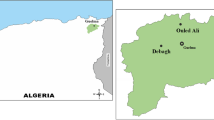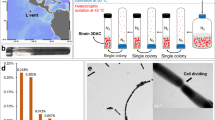Abstract
Members of Thermococcales are organoheterotrophic hyperthermophilic anaerobes consisting of three genera, Thermococcus, Pyrococcus, and Palaeococcus, among which Thermococcus are the most frequently isolated. In this study, a variety of Thermococcales strains were isolated from theGuaymas Basin hydrothermal vents under different temperatures and pressures. Based on their 16S rRNA gene sequences, all the strains isolated from 85°C or 95°C enrichment cultures at ambient pressure were classified as Thermococcus, while strains isolated from 108°C-30MPa enrichment cultures belonged to Pyrococcus. The combination of high pressure and high temperature for enrichment was shown to be an efficientmethod for isolating Pyrococcus strains. Through selecting and analyzing with multiple molecular phylogeneticmarkers, the isolated Thermococcales strains were found quite diversified including several putative novel species. This demonstrates a vast genetic reservoir of Thermoccoccales in the deep-sea hydrothermal vents, and a fast evolving of the Thermococcales species adapting to the fast changing environment.
Similar content being viewed by others
References
Achenbach-Richter L, Gupta R, Zillig W, et al. 1988. Rooting the archaebacterial tree: the pivotal role of Thermococcus celer in archaebacterial evolution. Systematic and Applied Microbiology, 10: 231–240
Altschul S, Madden T, Schaffer A, et al. 1997. Gapped BLAST and PSIBLAST: a new generation of protein database search programs. Nucleic Acids Research, 25: 3389–3402
Bertoldo C, Antranikian G. The order Thermococcales. In: Dworkin M, Falkow S, Rosenberg E, et al., eds. The Prokaryotes. 3rd ed. vol 3. New York, NY: Springer, 69–81
Brazelton W, Baross J. 2009. Abundant transposases encoded by the metagenome of a hydrothermal chimney biofilm. The ISME Journal, 3: 1420–1424
Cammarano P, Palm P, Creti R, et al. 1992. Early evolutionary relationships among known life forms inferred from elongation factor EF-2/EF-G sequences: phylogenetic coherence and structure of the archaeal domain. Journal of Molecular Evolution, 34: 396–405
Creti R, Ceccarelli E, Bocchetta M, et al. 1994. Evolution of translational elongation factor (EF) sequences: reliability of global phylogenies inferred fromEF-1 alpha(Tu) and EF-2(G) proteins. Proceedings of the National Academy of Sciences of the United State of America, 91: 3255–3259
Creti R, Citarella F, Tiboni O, et al. 1991. Nucleotide sequence of a DNA region comprising the gene for elongation factor 1 alpha (EF-1 alpha) from the ultrathermophilic archaeote Pyrococcus woesei: phylogenetic implications. Journal of Molecular Evolution, 33: 332–342
Fiala G, Stetter K. 1986. Pyrococcus furiosus sp. nov. represents a novel genus of marine heterotrophic archaebacteria growing optimally at 100°C. Archives of Microbiology, 145: 56–61
Flores G E, Wagner I D, Liu Yitai, et al. 2012. Distribution, abundance, and diversity patterns of the thermoacidophilic “deep-sea hydrothermal vent euryarchaeota 2”. Frontiers inMicrobiology, 3: 47
Fukui T, Atomi H, Kanai T, et al. 2005. Complete genome sequence of the hyperthermophilic archaeon Thermococcus kodakaraensis KOD1 and comparison with Pyrococcus genomes. Genome Research, 15: 352–363
Holden J F, Baross J A. 1995. Enhanced thermotolerance by hydrostatic pressure in the deep-sea hyperthermophile Pyrococcus strain ES4. FEMS Microbiology Ecology, 18: 27–34
Holden J F, Takai K, Summit M, et al. 2001. Diversity among three novel groups of hyperthermophilic deep-sea Thermococcus species fromthree sites in the northeastern Pacific Ocean. FEMSMicrobiology Ecology, 36: 51–60
Horikoshi K. 1998. Barophiles: deep-sea microorganisms adapted to an extreme environment. Current Opinion in Microbiology, 1: 291–295
Huber J, Butterfield D, Baross J. 2006. Diversity and distribution of subseafloor Thermococcales populations in diffuse hydrothermal vents at an active deep-sea volcano in the northeast Pacific Ocean. Journal of Geophysical Research, 111: 1–13
Ko K, Kim J, Kim J, et al. 2004. Population structure of the Bacillus cereus group as determined by sequence analysis of six housekeeping genes and the plcR gene. Infection and immunity, 72: 5253–5261
Larkin M, Blackshields G, Brown N, et al. 2007. Clustal W and Clustal X version 2.0. Bioinformatics, 23: 2947–2948
Lepage E, Marguet E, Geslin C, et al. 2004. Molecular diversity of new Thermococcales isolates from a single area of hydrothermal deep-sea vents as revealed by randomly amplified polymorphic DNA fingerprinting and 16S rRNA gene sequence analysis. Applied and EnvironmentalMicrobiology, 70: 1277–1286
Mardanov A, Ravin N, Svetlitchnyi V, et al. 2009. Metabolic versatility and indigenous origin of the archaeon Thermococcus sibiricus, isolated from a Siberian oil reservoir, as revealed by genome analysis. Applied and Environmental Microbiology, 75: 4580–4588
Marteinsson V T, Birrien J, Reysenbach A, et al. 1999. Thermococcus barophilus sp. nov., a new barophilic and hyperthermophilic archaeon isolated under high hydrostatic pressure from a deepsea hydrothermal vent. International Journal of Systematic Bacteriology, 49: 351–359
Marteinsson V T, Moulin P, Birrien J, et al. 1997. Physiological responses to stress conditions and barophilic behavior of the hyperthermophilic vent archaeon Pyrococcus abyssi. Applied and Environmental Microbiology, 63: 1230–1236
Orphan V, Taylor L, Hafenbradl D, et al. 2000. Culture-dependent and culture-independent characterization of microbial assemblages associated with high-temperature petroleum reservoirs. Applied and EnvironmentalMicrobiology, 66: 700–711
Takai K, Sugai A, Itoh T, et al. 2000. Palaeococcus ferrophilus gen. nov., sp. nov., a barophilic, hyperthermophilic archaeon from a deep-sea hydrothermal vent chimney. International Journal of Systematic and Evolutionary Microbiology, 50: 489–500
Tamura K, Dudley J, Nei M, et al. 2007. MEGA4: molecular evolutionary genetics analysis (MEGA) software version 4.0. Molecular Biology and Evolution, 24: 1596–1599
Tamura K, Nei M, Kumar S. 2004. Prospects for inferring very large phylogenies by using the neighbor-joining method. Proceedings of the National Academy of Sciences of the United States of America, 101: 11030–11035
White J, Escobar-Paramo P, Mongodin E, et al. 2008. Extensive genome rearrangements and multiple horizontal gene transfers in a population of pyrococcus isolates from Vulcano Island, Italy. Applied and EnvironmentalMicrobiology, 74: 6447–6451
Xie Wei, Wang Fengping, Guo Lei, et al. 2011. Comparative metagenomics of microbial communities inhabiting deep-sea hydrothermal vent chimneys with contrasting chemistries. The ISME Journal, 5: 414–426
Zeng Xiang, Birrien J, Fouquet Y, et al. 2009. Pyrococcus CH1, an obligate piezophilic hyperthermophile: extending the upper pressure-temperature limits for life. The ISME Journal, 3: 873–876
Zivanovic Y, Armengaud J, Lagorce A, et al. 2009. Genome analysis and genome-wide proteomics of Thermococcus gammatolerans, the most radioresistant organism known amongst the Archaea. Genome Biology, 10: R70.71–R70.23
Author information
Authors and Affiliations
Corresponding author
Additional information
Foundation item: The National Basic Research Program of China under contract No. 2011CB808800; the National Natural Science Foundation of China under contract No. 40830213; the Science and Technology Commission of Shanghai Municipality under contract No. 10JC1406700; the State Key Laboratory of Ocean Engineering in China under contract No. GKZD010053-1; US-National Science Foundation under contract No. OCE-0728391.
Rights and permissions
About this article
Cite this article
Liu, L., Wang, F., Xu, J. et al. Molecular diversity of Thermococcales isolated from Guaymas Basin hydrothermal vents. Acta Oceanol. Sin. 32, 75–81 (2013). https://doi.org/10.1007/s13131-013-0323-3
Received:
Accepted:
Published:
Issue Date:
DOI: https://doi.org/10.1007/s13131-013-0323-3




